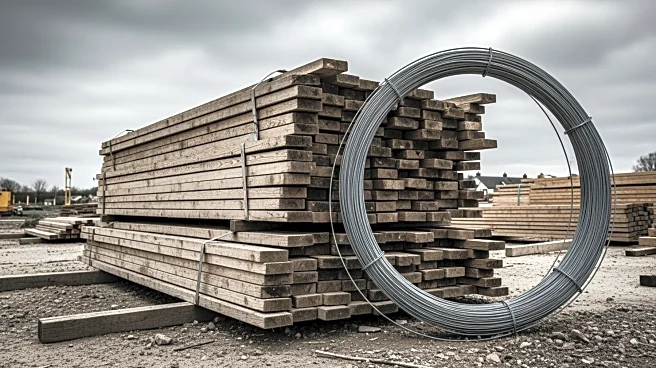What's Happening?
The construction industry is experiencing a downturn, as indicated by the latest Royal Institution of Chartered Surveyors (RICS) market survey. The headline workloads indicator has fallen to a net balance
of -8% in the third quarter of 2025, marking a return to negative territory after a brief period of stability. New project work has seen the sharpest decline, with a net balance of -13%, while repair and maintenance work remains flat. Infrastructure is the only sector showing positive growth, albeit at a slower pace, with a net balance of +8%. Financial constraints and regulatory barriers are cited by over 60% of respondents as key impediments to activity. Despite recent interest rate cuts, credit availability expectations have worsened, and demand-side pressures are increasing, with insufficient demand cited as a key barrier to growth by 41% of respondents.
Why It's Important?
The decline in construction activity has significant implications for the broader economy, as the industry is a major contributor to economic growth and employment. The ongoing skilled labor shortages exacerbate the situation, leading to increased labor costs and project delays. The decline in new projects and subdued demand could lead to further economic instability, affecting related industries such as real estate and manufacturing. The pressure on profit margins and employment expectations suggests that contractors may face financial difficulties, potentially leading to layoffs and reduced investment in future projects. The industry's challenges reflect broader economic uncertainties, including slow planning approvals and investor caution due to high build costs.
What's Next?
The construction industry may need to adapt to the changing economic landscape by exploring new strategies to attract skilled labor and improve efficiency. Policymakers might consider measures to ease financial constraints and regulatory barriers to stimulate growth. The industry could also benefit from increased investment in infrastructure projects, which remain relatively resilient. Stakeholders, including government agencies and private investors, may need to collaborate to address the demand-side pressures and ensure the industry's long-term sustainability. Monitoring the impact of interest rate changes and credit availability will be crucial in assessing future industry trends.
Beyond the Headlines
The construction industry's challenges highlight the need for a strategic approach to workforce development and training. Addressing the skilled labor shortage requires investment in education and vocational training programs to equip workers with the necessary skills. The industry's reliance on contingent workforces may also need reevaluation to ensure stability and sustainability. Additionally, the focus on infrastructure projects could drive innovation in sustainable construction practices, aligning with broader environmental goals. The industry's evolution may also influence urban planning and development, shaping the future of cities and communities.











